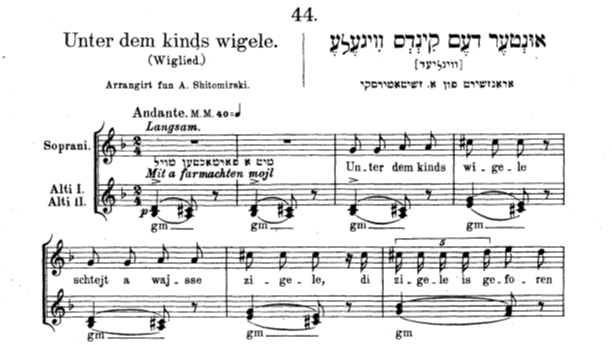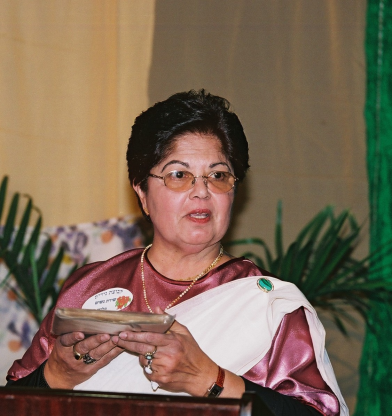
Stutschewsky described the Yiddish lullaby as a genre as follows:
Here lies the moment for a gentle song, to which toddlers listen attentively, cuddling within its soothing cover. In a soft voice, both praising and bagging, the mother calls destiny and demands from it a better future for her son. ----- The dark and gloomy atmosphere that characterizes the lullabies, depicts the people’s mood.” (Stutschewsky 1958: 33)
The lullaby Unter dem kinds wiegele is an original and appropriate opener for a Jewish life-cycle. Quiet, slow-paced, and transparent it seems approachable for the amateur player as well as for the listener. Yet, a dimension of self-awareness resonates through a mixture of worrisome and restlessness currents bubbling beneath the gentleness of the cradlesong. The word Unter [Under] in the title is a most appropriate description for the piano accompaniment by the left hand only. Stutschewsky, most likely came across this song in the vocal arrangements by Alexander Schitomirsky (in Kisselgoff, Schitomirsky and Lwow 1912, no. 44) or Joel Engel (1923, no. 24). Stutschewsky’s arrangement shares the A freygish tonality with Schitomirsky’s. The two humming alto voices in Schitomirsky’s vocal accompaniment create a soft sway pattern background, an effect that perhaps inspired Stutschewsky’s piano accompaniment to song no. 8 of this album.
"Unter dem kinds wigele" arranged by Alexander Schitomirasky (Kisselgoff, Schitomirsky and Lwow 1912, no. 44)

“Unter dem Kinds Wiegele” arranged by Joel Engel

The lullaby’s melody opens with calm, even quarter notes and is reinstated with a quarter note triplet rhythm in the next phrase. This contemplative rhythmic expression is underlined with an idiomatic bowing called louré[1] articulation (in bar 3). From a pedagogic viewpoint, this allows amateur string players to experiment with different kinds of bow articulation within a narrow tonal range and slow tempo. The melody flows above a persistent eights-note sway in the piano’s accompaniment. The piano wanders through spooky and dissonant descending and ascending fifths, tritons, sixths and sevenths. The persistent accompaniment imitates the rocking of the cradle. However, it is underlined by foreign tones as well as by rhythmic groupings independent from the melody’s phrasing. Nevertheless, the ending on an A major chord conveys the strength of the unbreakable mother-child bond. Perhaps it also hints to the hopes and emotions engrained in the modern national rebirth of the Jewish people.
Concerned about the album’s reception by the amateur pianist, Engel commented on the pedal marking (Ped):
In the piano part mark Ped. at least in the first two bar or write a sustained half note, as you did in the last bar. For you need to imagine yourself in the place of an [average] accompanist (of such album). Not a modern pianist who would guess your intention by hint only, but an autodidact that would be baffled just from the sight of the awkward accompaniment (bar-crossing slurs), strange harmonies, and therefore would need guidance. This [comment] is relevant to the entire album.[2]
Eventually the pedal sign was introduced all along this piece emphasizing the unconventional harmonic movement.
____________________
[1] Louré (French) or portato (Italian) – slightly detached notes played in the same bow direction.
[2] Engel to Stutschewsky, July 20, 1924. Stutschewksy archive 3/2/1: 174/4.





